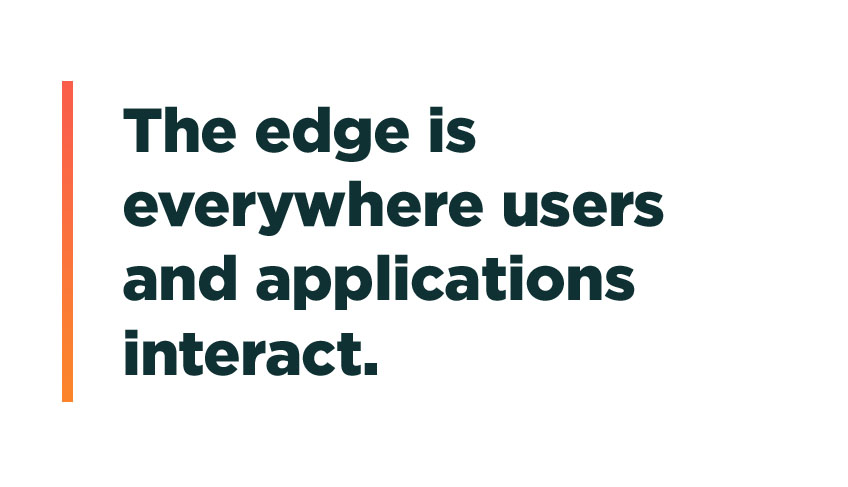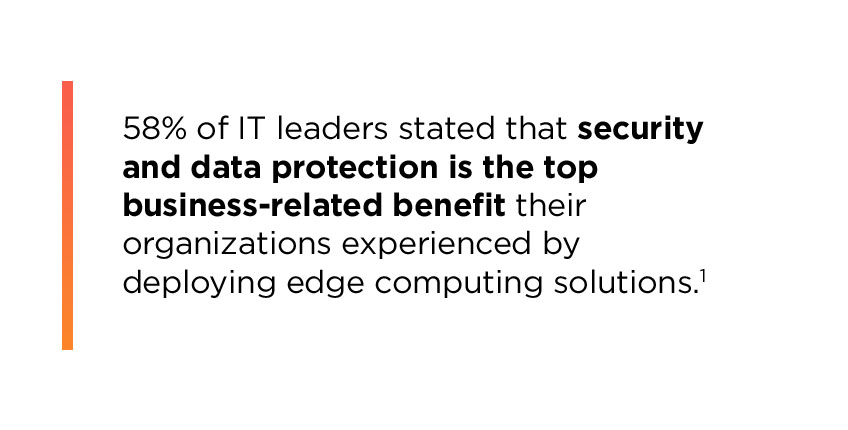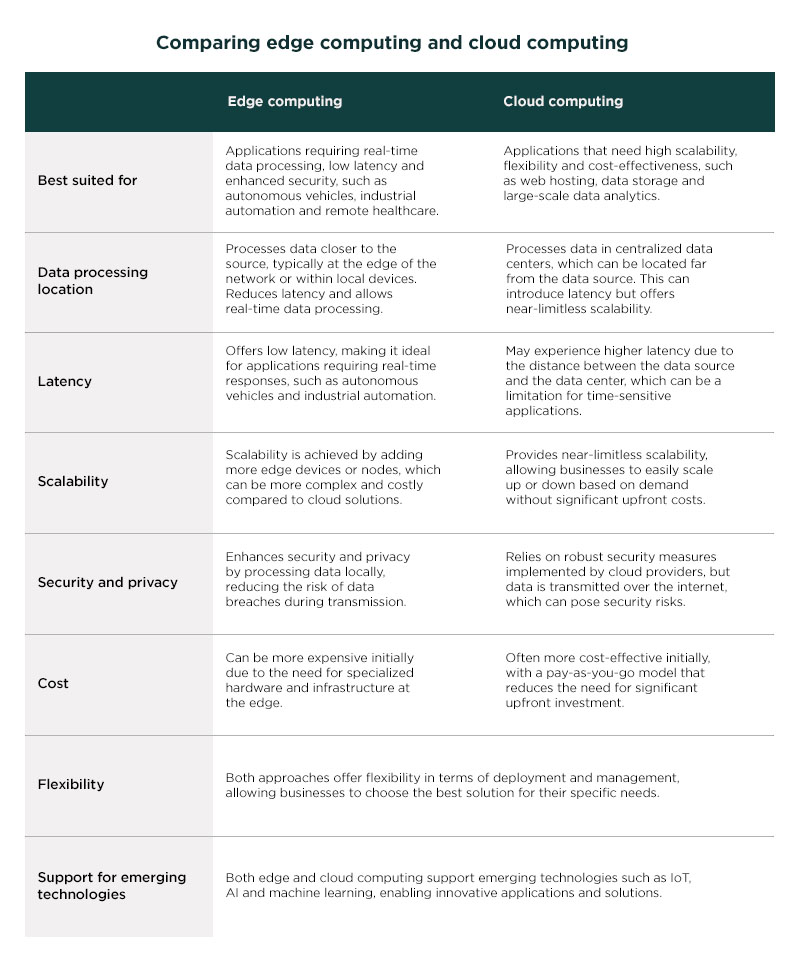What Is edge computing?

Edge computing is one of the fastest-growing enterprise technologies. But what exactly is the edge? How does it work? And where is it located? Learn all this and more, including how low-latency edge computing can help your organization innovate faster and optimize your high-performance applications to deliver exceptional user experiences.
Why edge computing is so important
Before we try to define the edge, we need to understand the forces driving the demand for edge computing solutions.
We are in the midst of a digital revolution that is driving enterprises to invest heavily in data-driven artificial intelligence (AI) and machine learning (ML) processes. These applications help organizations drive efficient business operations, create new revenue opportunities and develop innovative new products and services to differentiate their brands from competitors.
Many organizations have adopted the public cloud for its high availability, rapid scaling of compute resources and ability to reduce infrastructure complexity. But even with these advantages, most data processing still takes place in a centralized location, the traditional data center. On their own, cloud services are simply not enough to power latency-intensive next-gen applications. Enter edge computing, also known as edge cloud.
Edge computing explained
In simple terms, edge computing is the practice of acquiring, processing and analyzing data where it is created so it can provide immediate value to your business. This proximity to data at its source substantially reduces the time needed to make decisions based on the data, and that can provide a major advantage to your business.
But where is the network edge exactly? Just like its name implies, edge computing takes place at the edge of corporate networks where the physical and digital worlds interact. It’s where data is input into or captured by devices that are connected to the internet or a network, and where devices receive data that users and applications rely on for decision-making and insights.
The edge can be on-premises, near premises, in a metro cloud or on user devices ranging from point-of-sale kiosks to autonomous vehicles. It can be a retail store, factory, hospital or devices all around us, such as traffic lights or wearable technology.
Rather than sending data generated by edge devices through a central data center or to the cloud, an edge network processes and stores most data on-premises or on nearby servers and only sends essential information to the cloud or to a central data center, drastically reducing processing latency. Edge computing is often used in remote locations where real-time computing isn’t usually possible, such as construction sites, factories, hospitals, farms—even on submarines and the International Space Station.
Edge bare metal servers play a crucial role in the edge computing ecosystem. These servers provide the raw, dedicated hardware resources needed to handle intensive computational tasks at the edge of the network. Unlike virtualized environments, bare metal servers offer direct access to the hardware, resulting in higher performance and lower latency.

The synergy between edge computing and AI
Edge computing and artificial intelligence (AI) are technologies that can work together to improve the performance and efficiency of modern applications. AI algorithms require large amounts of data and computational power to function effectively. This data processing has typically been handled in centralized cloud data centers. However, as the amount of data generated by IoT devices and other sources continues to grow, the limitations of cloud computing—such as latency and bandwidth constraints—are more apparent.
Edge computing addresses these challenges by bringing data processing closer to the source of data generation. This proximity allows for real-time data analysis and decision-making, which is crucial for AI applications that require immediate responses. Not only that, but edge computing can also improve the efficiency of AI models by reducing the amount of data that needs to be transmitted to central servers. This not only lowers bandwidth costs but also enhances data privacy and security by keeping sensitive information local.
The integration of edge computing and AI creates a powerful synergy that enhances the performance, efficiency and security of applications across various industries. By maximizing the strengths of both technologies, your organization can unlock new opportunities for innovation and growth.
Benefits of edge computing
From more efficient operations to enhanced data protection, edge computing offers a wealth of advantages that can significantly enhance your business operations and user experiences, including:
Faster response times
Milliseconds make a difference for many applications. Edge computing enhances responsiveness, speed, and overall service quality by positioning data analysis tools and applications closer to the data source. This minimizes the physical distance that data needs to travel and reduces data transfer time. Additionally, it decreases network congestion and periods of inactivity or lag.
More robust data security
Data security is more essential than ever these days. Edge computing helps by processing sensitive information locally instead of in central locations. Keeping critical data close reduces cyberattack risks while encryption and firewalls on edge devices also help prevent unauthorized access.
Reliability and resiliency
By decentralizing computing resources across the network, businesses can mitigate the risk associated with a single point of failure. In conventional centralized architectures, an outage of the central server or data center can disrupt the entire network. But with edge computing, if one node fails, the remaining parts of the network can continue to operate independently.
Cost optimization
Edge computing reduces the need for data transfer to central data centers or the cloud, lowering bandwidth and storage expenses. It also minimizes the need for expensive on-premises infrastructure, lowering maintenance and upgrade costs while optimizing real estate and energy usage. These are important advantages for asset-intensive industries like manufacturing and utilities.
Enhanced scalability
Edge computing boosts scalability by spreading out processing power across multiple edge nodes close to where the data is generated. This method expands your network without overloading a central server by distributing processing tasks. It handles increased workloads smoothly and simplifies scaling up
Network efficiency
Networks using edge computing provide superior performance, faster response times and fewer periods of downtime. Because edge computing processes data locally on devices, less data travels between networks, helping to prevent congestion.
 Industry uses of edge computing
Industry uses of edge computing
By bringing computation and data storage closer to where it’s needed, edge computing supports applications requiring immediate insights and actions. Here are six impactful use cases of edge computing that demonstrate its transformative potential to businesses and society.
- Healthcare data processing: Remote patient monitoring (RPM) and Internet of Medical Things (IoMT) devices can continuously monitor patients’ vital signs, including weight, blood pressure, heart rate, glucose levels and blood oxygen levels. This can be done from home or wherever the patient is.
- Autonomous vehicles: Self-driving cars rely on edge computing to process data from sensors and cameras in real-time. This enables quick decision-making and improves safety by allowing the vehicle to respond promptly to changing conditions and hazards.
- Smart cities: Edge computing supports smart city initiatives by processing data from various sensors and devices locally. This helps with managing traffic, monitoring air quality and enhancing public safety. For example, traffic data can be analyzed in real-time to optimize traffic light patterns and reduce congestion.
- Retail: Retail stores use edge computing for facial recognition payment processing, which speeds up checkout times and enhances the customer experience. This technology also helps in inventory management and personalized marketing by analyzing customer behavior and preferences.
- Industrial IoT: In manufacturing, edge computing is used to monitor equipment and predict maintenance needs, reducing downtime and improving efficiency. By analyzing data from sensors on the factory floor, manufacturers can identify potential issues before they lead to equipment failure.
- Public sector: In the public sector, edge applications can include real-time monitoring of critical infrastructure like power grids or water systems. They also cover public safety uses such as emergency response, real-time crime detection and contact tracing during public health emergencies.
Understanding and prioritizing high-value use cases will be essential for any business planning to move to the edge. Now, let’s see how edge stacks up against traditional cloud computing and which approach might be best for your needs.
Edge computing vs. cloud computing: Which approach is right for you?
Edge computing is data analysis that takes place locally on a device in real time while cloud computing is about processing data in a data center or public cloud. The good news is that you don’t need to choose between them. Both cloud and edge computing offer unique advantages and can complement each other in a hybrid environment.

Edge computing and cloud computing are like two sides of the same coin when it comes to handling data. By understanding each model’s strengths, you can build a powerful, efficient IT infrastructure that meets modern data demands.
All-in-one infrastructure for the anywhere edge
If you’re striving to meet the demands of data-driven business, edge is no longer a trend but a requirement. To deliver next-gen applications and enhanced customer experiences, you need an ecosystem of advanced technologies offering scale, speed, security and intelligence. One that also helps lower your total cost of ownership and simplifies your IT environment.
Lumen is a leader in the technology needed to build a future-ready, optimized edge. Our edge cloud infrastructure is a fully integrated stack of compute, cloud, storage, networking, cybersecurity and orchestration that makes it easy to scale up resources to the capacity, bandwidth, latency, processing power and number of locations you need, so you can unleash your organization’s digital potential.
Find out how you can achieve compelling, quantifiable benefits from edge computing with Lumen® Edge Cloud Solutions.
1IDC, A Strategic Look at Edge Computing, March 2023.
This content is provided for informational purposes only and may require additional research and substantiation by the end user. In addition, the information is provided “as is” without any warranty or condition of any kind, either express or implied. Use of this information is at the end user’s own risk. Lumen does not warrant that the information will meet the end user’s requirements or that the implementation or usage of this information will result in the desired outcome of the end user. All third-party company and product or service names referenced in this article are for identification purposes only and do not imply endorsement or affiliation with Lumen. This document represents Lumen products and offerings as of the date of issue. Services not available everywhere. Lumen may change or cancel products and services or substitute similar products and services at its sole discretion without notice. ©2024 Lumen Technologies. All Rights Reserved.
Related Content
5 Edge Computing Use Cases Revolutionizing Retail





